12 Tips For Making Potatoes In The Slow Cooker
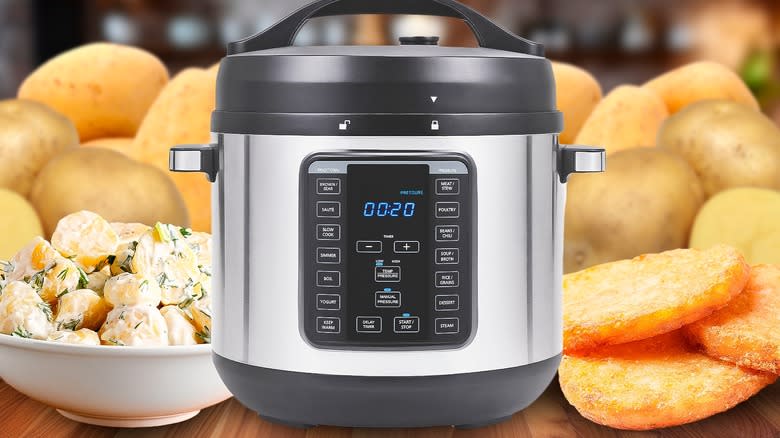
A slow cooker sometimes gets a bad rep in the kitchen, starting with its unflattering name. In this age of fast and furious instant recipes, waiting for food to cook in a slow cooker can seem like a step backward. After all, as its name implies, a slow cooker takes its sweet time to make your dish. It's slow, methodological, and requires a little effort on your end to get it going. Among the tips you'll need when cooking with a slow cooker, pre-heating the unit and prepping your ingredients the night before are key to creating a tasty meal.
But for foods that can take a while to cook, like potatoes, using a slow cooker is totally doable and a great alternative to a conventional oven or boiling pot of water. Depending on your slow cooker's setting, it can take anywhere from 4 to 8 hours to soften your potatoes in the slow cooker, which is a bit longer than using other appliances. But one great advantage of using a slow cooker is that the unit does the leg work and lets you multitask. Rather than waste energy and time heating up your entire kitchen or monitoring your oven, you can simply let your potatoes cook while you go about your day, even if that means being a couch potato.
But don't just toss some random taters into a Crockpot and crank up (or down) the dial as you dash out of the kitchen to run your errands. Cooking potatoes in a slow cooker can be pretty easy, but some tips can help ensure that your spuds won't end up as duds.
Read more: Tips You Need When Cooking With Ground Beef
Know Your Potatoes
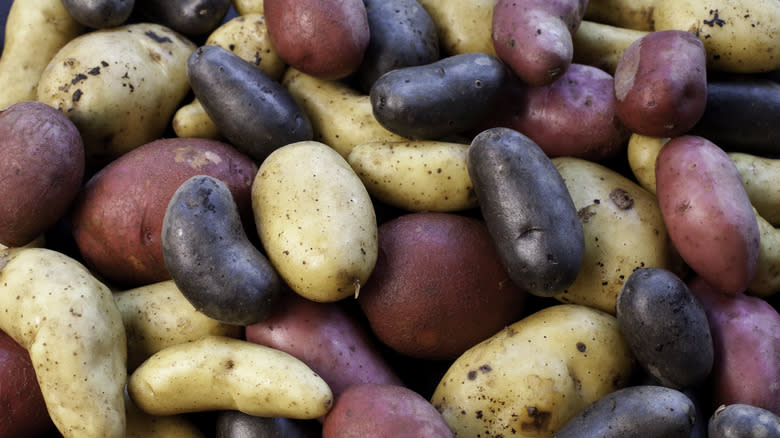
It doesn't matter if you say "potato" or "potatoe," know that not every potato is created equal. Nature has provided many different types of potatoes, and if you're selecting potatoes for their gold, red, purple, or orange hues because they look neat or simply going for the large sacks of russets at the local grocery store out of sheer convenience, you might not be prepping the right tuber for your table. Speaking of russets, these starchy spuds are the most common ones used for baking, but Kennebecs and Bintje taters are also great for roasting.
One of the key requirements when selecting your spuds is the starch content. The difference between potatoes used for baking and boiling is that baking potatoes should have high starch content, which allows the potato to become light and airy. Boiling potatoes tend to have lower starch content, and the potato becomes stickier as they soak up moisture. Smaller potatoes with low starch content, such as Red Bliss and Yukon Gold, are go-to standards for boiling. Knowing your spuds are no small potatoes; you'll already be a step ahead in flavor-locking your recipe by selecting the right variety.
Read Up On Your Slow Cooker
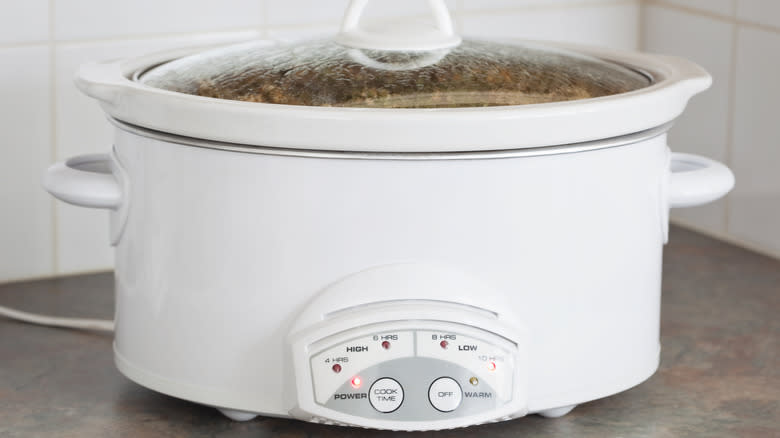
Slow cookers, like potatoes, come in all shapes, sizes, and temperaments. You don't have to be a tech wizard to know how your slow cooker works, as it's basically a pot with a heating unit. Most slow cookers just have a couple of settings: high, low, and medium, but don't be fooled by thinking that "hot" always means "hot" for each meal. Each slow cooker model has different parameters for what "high" and "low" settings actually mean, ranging from 165 to 175 F on "low" and up to 215 F for high, with some slow cookers ranging into 280 F, according to the USDA. If your recipe is temperature-sensitive, make sure you and your slow cooker are on the same page.
By knowing your slow cooker's particulars, you can avoid some common mistakes that everyone makes when prepping ingredients. With the unit's temperature setting in mind, you can gauge how long to pre-heat your slow cooker in advance before adding any food items. You'll also know which recipes your crock pot can safely accommodate. Overstuffing a slow cooker can lead to undercooked ingredients -- especially if you set the dial to "medium" instead of "high" or misjudge the cooking time needed -- and the last thing you need is to turn your slow cooker into a no cooker. An overstuffed slow cooker can also spill over, turning your Crockpot creation into, well, just a crock.
Lower The Amount Of Water In The Slow Cooker
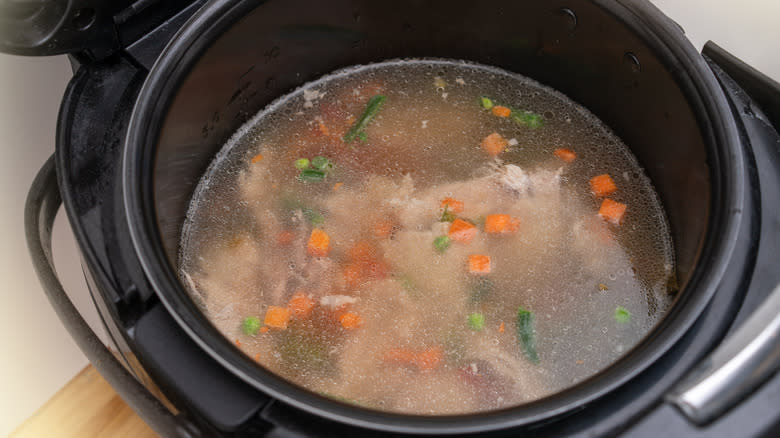
When cooking potatoes, a pot of boiling water is one of the tried-and-true methods of cooking your spuds. In Ireland, many common potato dishes require boiling potatoes as a principal step before mashing and mixing the taters into casseroles, soups, and pies. When it comes to boiling potatoes, a slow cooker is the right tool for the right job, especially if you're busy preparing a feast for St. Paddy's.
But there's a twist when boiling potatoes in a slow cooker. Don't add the same amount of water to a slow cooker as you would any other pot on the stove; instead, you should definitely use less liquid for slow cooker recipes. A slow cooker works by building up steam in your pot, which condenses and drips down from the enclosed lid back into the pot. This water cycle means that most of the liquid content added at the start will remain until it's done. If you have ingredients that release water when they cook, your water level will slowly rise over time, and the slow cooker might start to flood over.
One suggestion is to decrease the amount of water in your pot. Don't get the water level to the brim. Instead, filling your pot from halfway to three-quarters is one way to prevent an overflow of H2O in your pot. While the water might not seem enough to boil your taters to perfection, remember that your potatoes will be steam-cooked from the top down.
Flavor The Potatoes While They're Slow Cooking
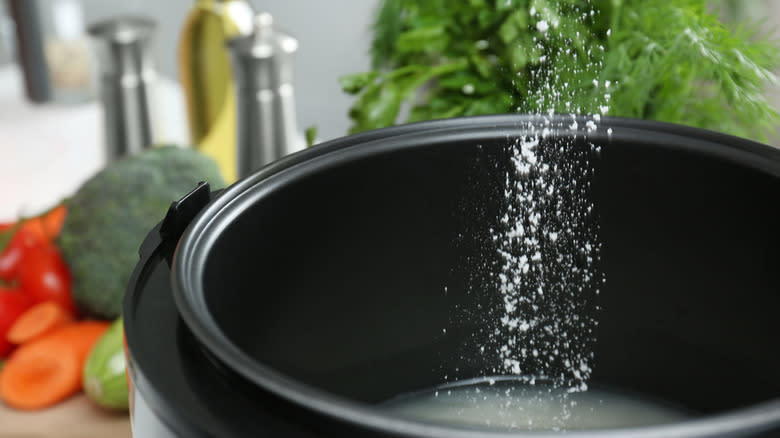
The long cooking time that slow cookers require allows them to soak up seasoning to amp up the flavor. But there's a catch: Most of your seasoning should be added at the start rather than at intervals during the cooking process. While a slow cooker's pot looks like its stove-top counterparts, once the lid is placed on top of the unit, it should ideally stay on until it's done. That means you'll have little opportunity for rotating ingredients or taste-testing at the midpoint without disrupting the temperature.
At first glance, this can sound like a red alarm. After all, chefs generally recommend constant taste-testing and adjusting. But think of the slow cooker as one long, uninterrupted soak session for the seasoning to pierce a potato's skin and starchy innards. Replacing water with chicken broth, for instance, can elevate your taters to have a slow-cooker chicken flavor. Add some salt, garlic, peppers, and other herbs into the cooking liquid that the potatoes will call home for the next few hours. By the time your slow cooker finishes its magic, your boiled potatoes will be bursting with flavor.
Place Your Ingredients In The Right Order
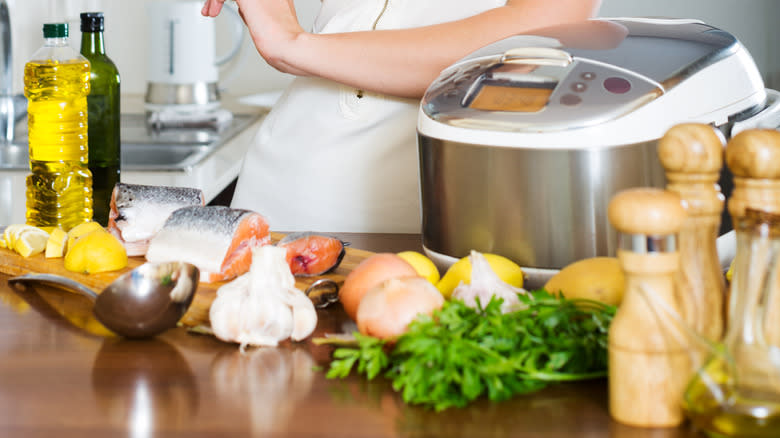
It might be tempting to just throw your potatoes into the slow cooker without too much fuss. After all, traditional slow cooker stews and soups don't require the same care as when layering a thick lasagna. But while we aren't assembling an Italian masterpiece, that doesn't mean we should be careful about how we set about filling a slow cooker. The slow cooker's enclosed steam environment means that once the ingredients are in, that's the way they'll generally stay until the serving time.
To make sure that your food is thoroughly cooked and the texture perfect, arrange your ingredients based on how much time they need to cook. Veggies and potatoes tend to take the longest time to heat up, so add the vegetables to a slow cooker before the meat. You'll also want to ensure that the spuds line the bottom of the pot. Softer veggies, like peas and cucumbers, aren't ideal for slow cooking and should avoid the Crockpot altogether, but potatoes can take up to eight hours for the slow cooker to do its thing. So, it's a safe bet that they'll always be the first to go in and the last to take out.
Keep Your Potatoes The Same Size
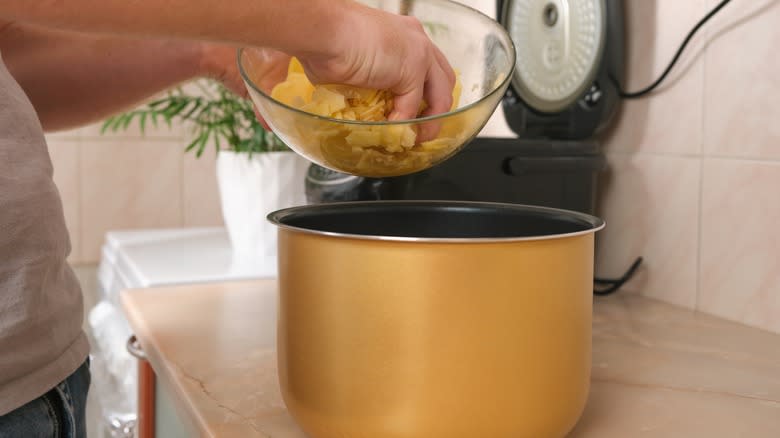
When arranging your potatoes in a slow cooker, it might be tempting to find a wee, little one that can fill in that corner crack among all the whole spuds lining the bottom. But if you're using an array of different-sized potatoes, you'll find that some tubers will remain raw hard while others will be mush. Having random-sized pieces in the pot will mean that the smaller ones might be covered completely in the cooking liquid, while larger ones are half-submerged like islands. Either way, the smaller spuds will end up gummy and overdone, while the larger ones will still need a longer steam bath.
The key to having all the potatoes turn out just right is to keep them consistent in terms of size. It doesn't matter whether you prefer your potatoes whole, halved, or in wedges -- they all need to have the same shape and size. If you're aiming to have a certain number of potatoes in the slow cooker or just want the potatoes to line the bottom of the pot to support the veggies and meat, it's best to select and arrange your potatoes ahead of time before prepping them.
Pierce The Potatoes Before Cooking
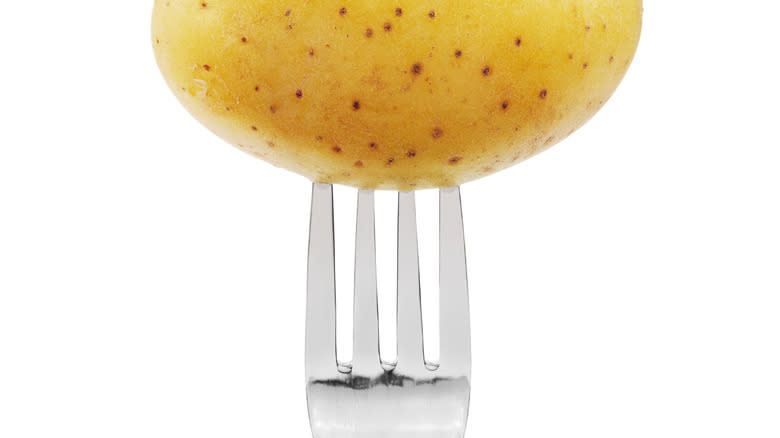
A slow cooker can replace the oven for certain potato dishes, but that doesn't mean that tips for conventional baked taters don't apply to slow cookers. If preparing whole potatoes for roasting, one tip you need to remember is to make sure to pierce them several times before setting them down in the pot. The pierced potatoes allow steam to escape from the inside so the pressure doesn't build up and cause the spud to burst like a firecracker in your Crockpot.
One caveat to roasting potatoes in the slow cooker: the slow cooker uses steam, rather than the heating element of a conventional oven, to cook your tubers. If overcooked, the potato can turn gummy from all the moisture around it, so it's best not to keep them in the "warm" setting once they're fully done. When roasting in a slow cooker, pierce them again with a fork after 3 hours on high to test them out. If they're tender and ready to go, take 'em out of the slow cooker.
Make Them Crispy
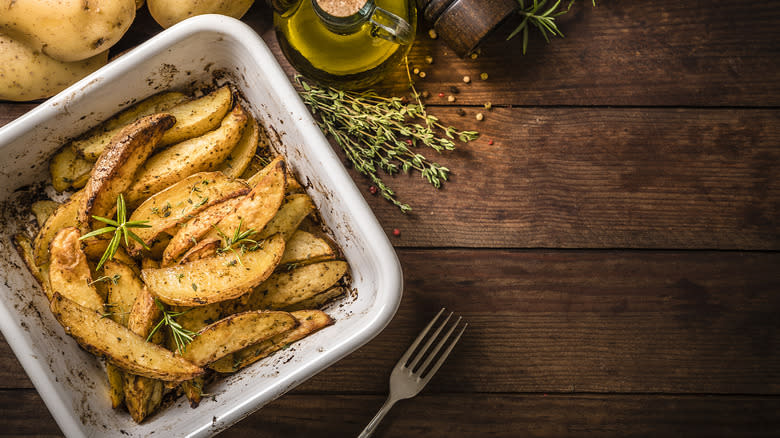
When it was first introduced in 1970, the slow cooker was used primarily for stewing beans and meat. For potatoes, this generally meant boiling them in preparation for a roast or a soup. But despite using steam power, a slow cooker can also make the crispiest potatoes this side of your oven. One insider hack is to parboil the potatoes for about 10 minutes before plain them in the slow cooker. By parboiling, you'll get a head start on cooking them by ensuring the potato flesh is cooked. That way, when you transfer your spuds to the slow cooker, you can concentrate on crisp-i-fying the outside without worrying about the insides staying raw.
Speaking of the slow cooker, the cooking liquid must be oil rather than water so that the exterior can fry while cooking. While using a slow cooker may not be as calorie-conscious as using a traditional oven, you can lower the cholesterol content by switching to olive oil. Add your seasoning and slow-cook them for about 3 hours on the highest setting. To preserve that crispy exterior, place a towel under the lid to prevent any steam from condensing and raining back down on your taters.
Use A Slow Cooker Instead Of A Frying Pan To Make Hash Browns
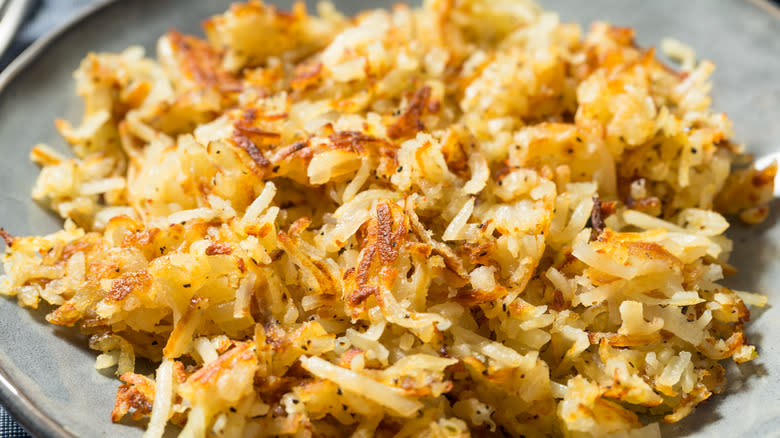
A slow cooker's long cooking time can also come in handy when you're on the go in the morning. This might sound like an oxymoron, but if you're short on time when you spring out of bed, a slow cooker logging the late hours the night before can help you get a balanced -- and delicious -- breakfast in time to make the morning commute.
Before you head off to bed, simply spray the bottom of your slow cooker with cooking oil before layering your hashed browns into the pot. Add enough salt, peppers, and other seasoning to taste. Set the temperature to low for 8 hours (or high for 6 hours, depending on how long you measure your 40 winks), and it'll be ready by the time your alarm clock sounds.
If you're into more deluxe renditions of hashed browns, Chef Erin Johnson's breakfast casserole is one easy way to transform frozen taters into a luxury casserole. This slow cooker breakfast eye-opener comes complete with sausage, eggs, and cheese to make sure your breakfast captures the four food groups.
Steam Them Up To Make Mashed Potatoes
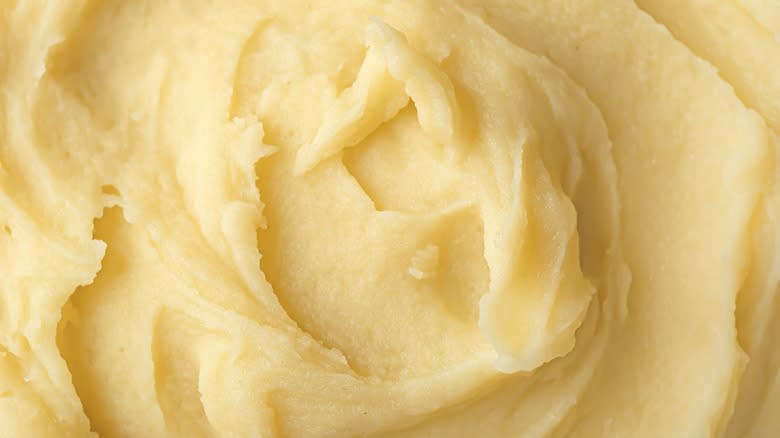
With slow cookers operating on full steam power, prepping mashed potatoes is a natural extension for the countertop Crockpot. Making mashed potatoes in a slow cooker is simple; just cut your potatoes into 1-inch cubes and then add them to the pot alongside milk and seasoning -- no boiling, no stirring, and no messes to clean up as the slow cooker does all the work. After cooking for 4 to 5 hours, turn off your slow cooker, mash the softened tater cubes with a spoon, and add butter and other toppings to taste.
Once you have the basic mashed potato recipe down pat, you can amp it up by adding other veggies like onions and chives, seasonings, and creams. One favorite is Kentucky Potatoes cooked cheesy, with the cheese topping ranging from mild Monterrey Jack to extra sharp cheddar. The beauty of it is that no extra pots or pans are needed; the slow cooker does all the work, and the pot even makes a handy serving dish when it's all over.
Make A Rich Potato Salad
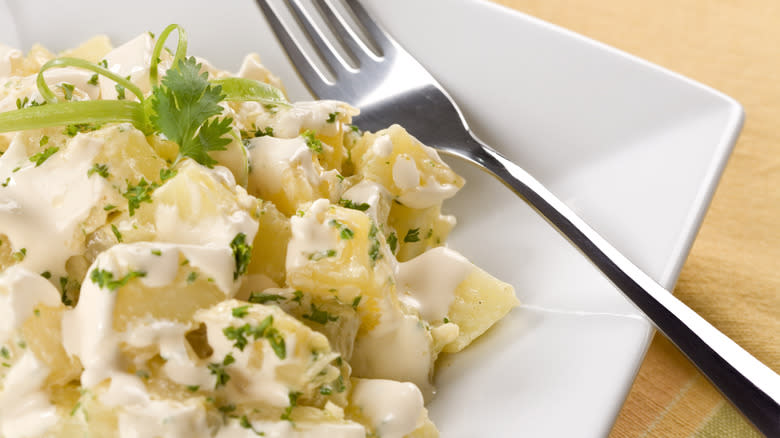
A slow cooker works great for prepping any recipe that calls for potatoes. When the weather turns warmer, and you don't want to heat the kitchen for hours on end, the slow cooker can cook your potatoes without worrying about breaking a sweat.
The slow cooker can also whip up a super easy one-pot potato salad. The slow cooker can soften your spuds with all the seasonings added, including any vinegar and broth. One advantage of a slow cooker is that you can prepare your eggs at the same time that your spuds are simmering; if making a regular potato salad, crack your eggs in a separate oven-safe bowl and place the bowl into the Crockpot. Make sure to keep the egg bowl separate from the potatoes and that none of the cooking liquid from the potatoes seeps into the bowl. The eggs will cook faster than the taters, so remove the bowl after about 1.5 hours and let the potatoes cook the rest of the way. Once your potatoes are done, place them on a plate to cool while preparing refrigerated ingredients like mayo and relish.
Practice Good Safety Measures
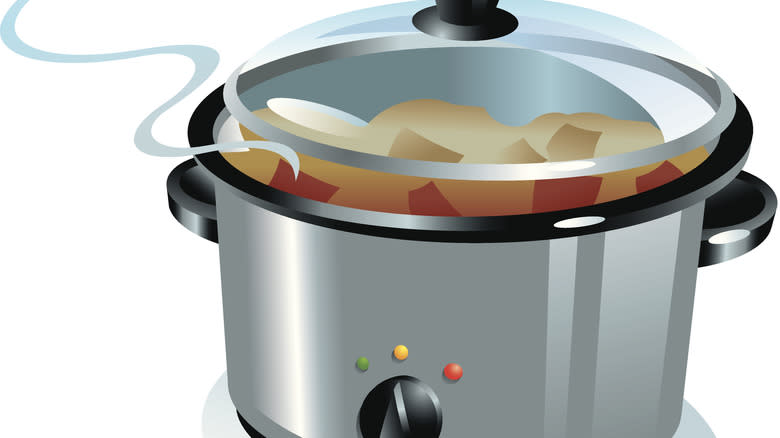
A slow cooker can save you effort and shave time off your busy culinary schedule. But, as with any kitchen appliance, accidents can happen if we aren't aware or become careless. With the slow cooker, the main thing we have to look out for isn't the electrical wiring or heating elements, but watch out that we don't get scalded.
The glass lid on the slow cooker is a pretty tempting target. It's almost instinctive to pick up the lid and get a whiff of the aroma of cooking taters or to stir the pot. But you should never open your slow cooker's lid when cooking. The released steam will instantly head upwards, hitting your arm, hand, and face with the energy and temperature of boiling water. Even when the slow cooker is done and turned off, carefully remove the lid to avoid getting burned.
One trick that can help control all that excess moisture is an easy towel trick to lower the condensation on the lid. Wrap a kitchen towel on the lid and secure it with a rubber band around the handle. The towel will soak up some escaping steam and shield your hand from that first salvo of steam. After all, the last thing you want is an accident that will have you dropping your slow cooker like a hot potato.
Read the original article on Tasting Table.

